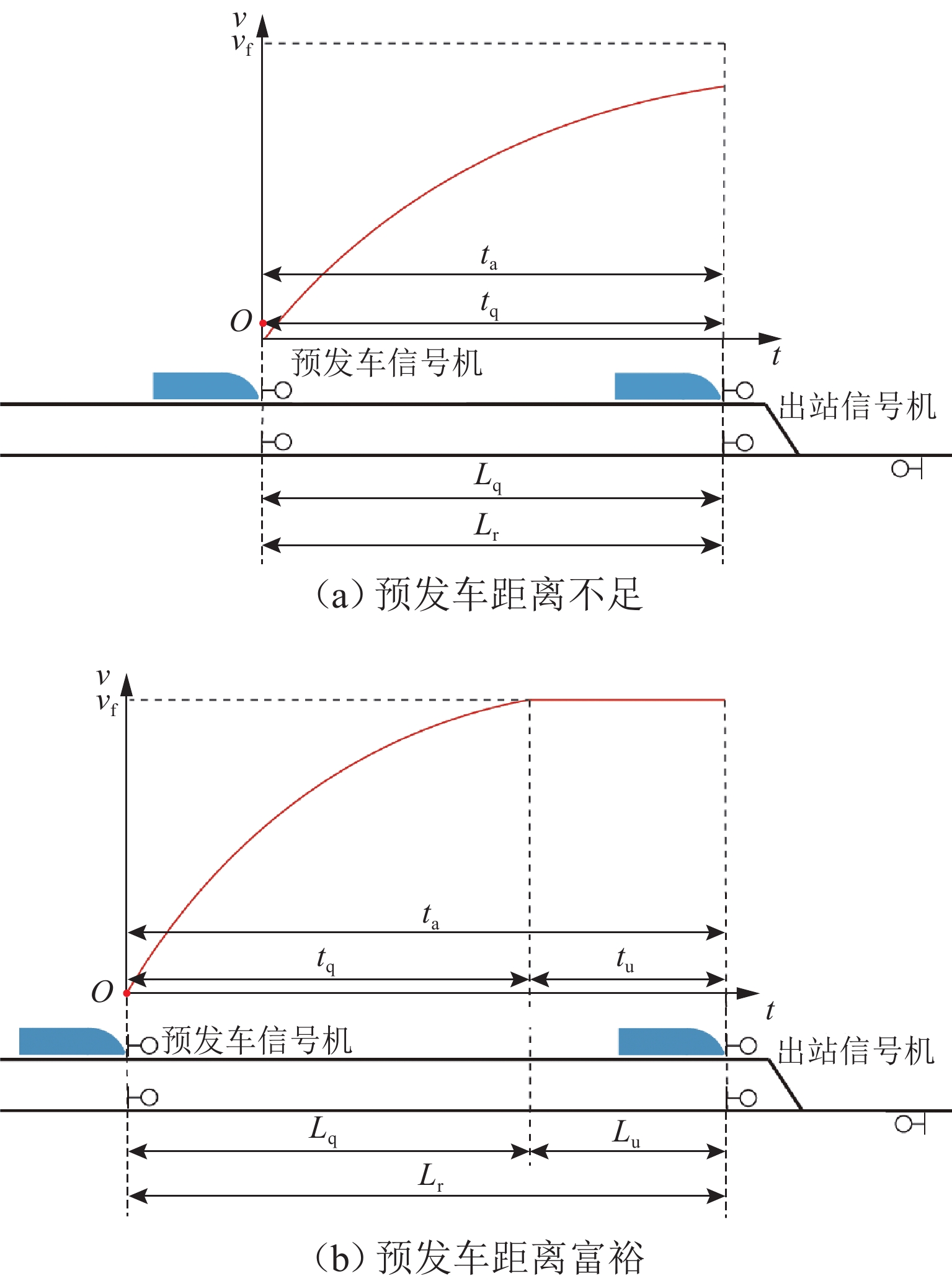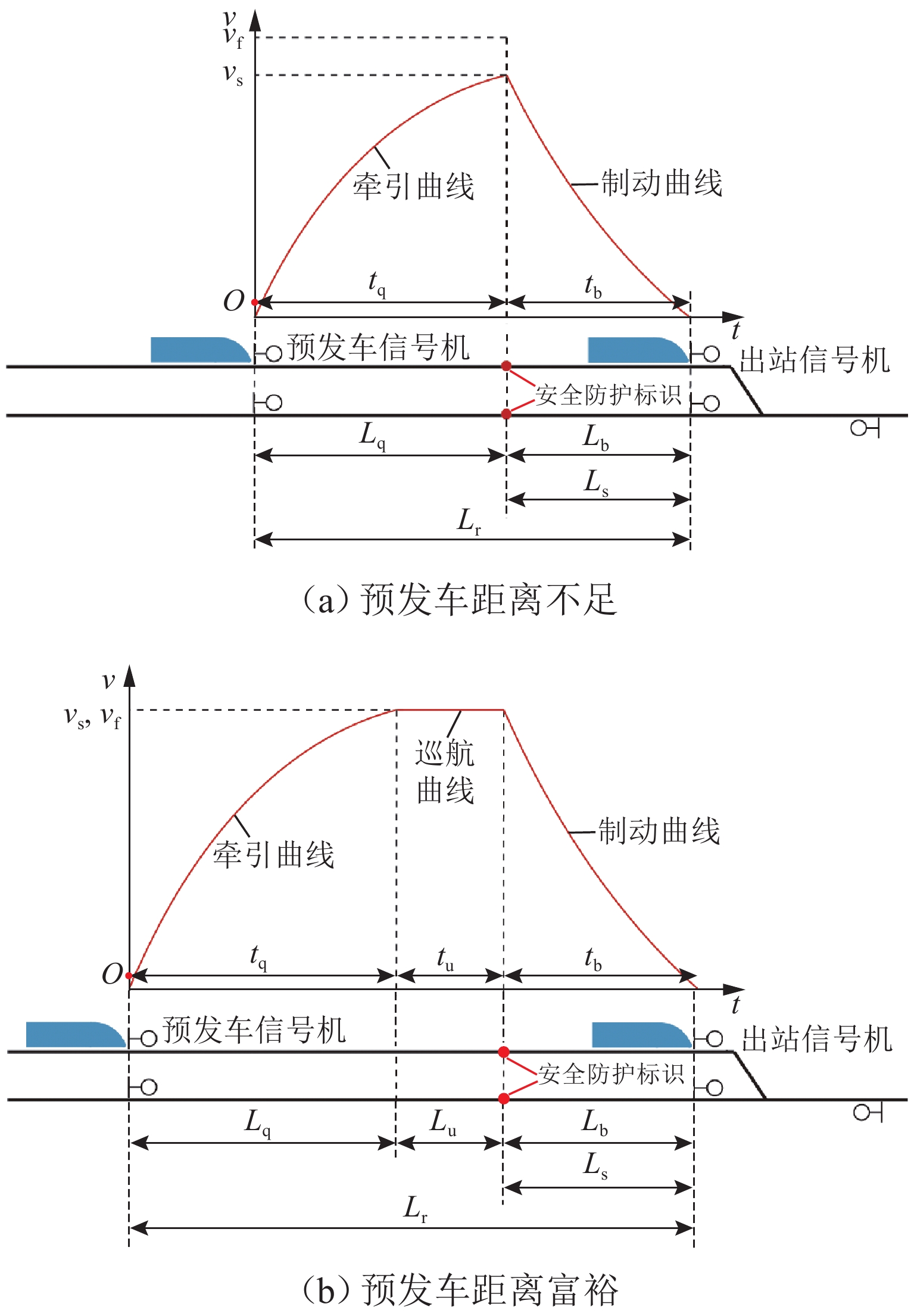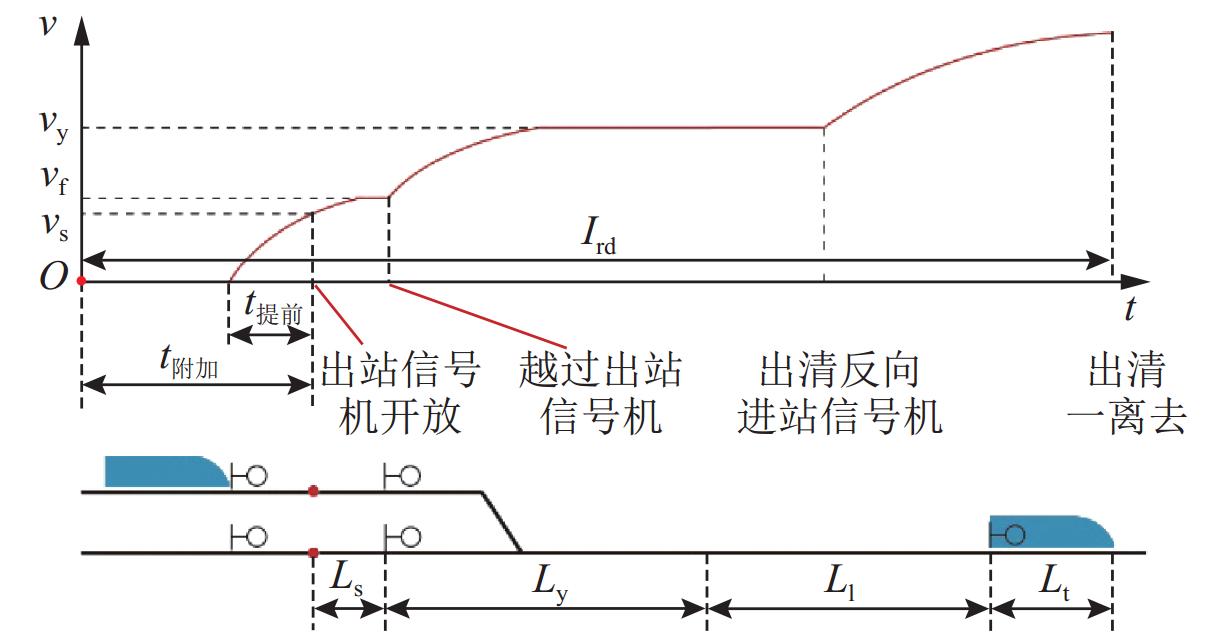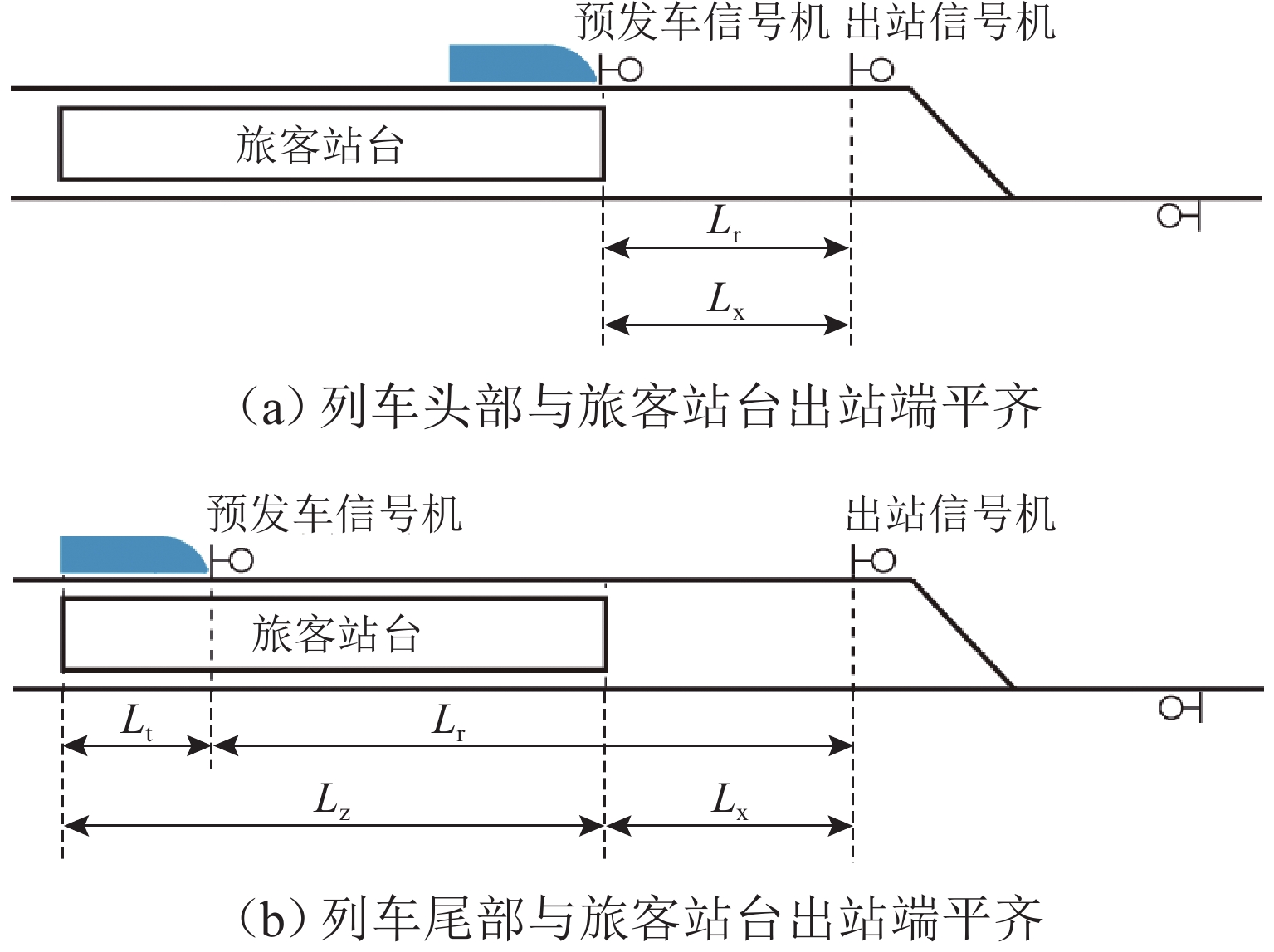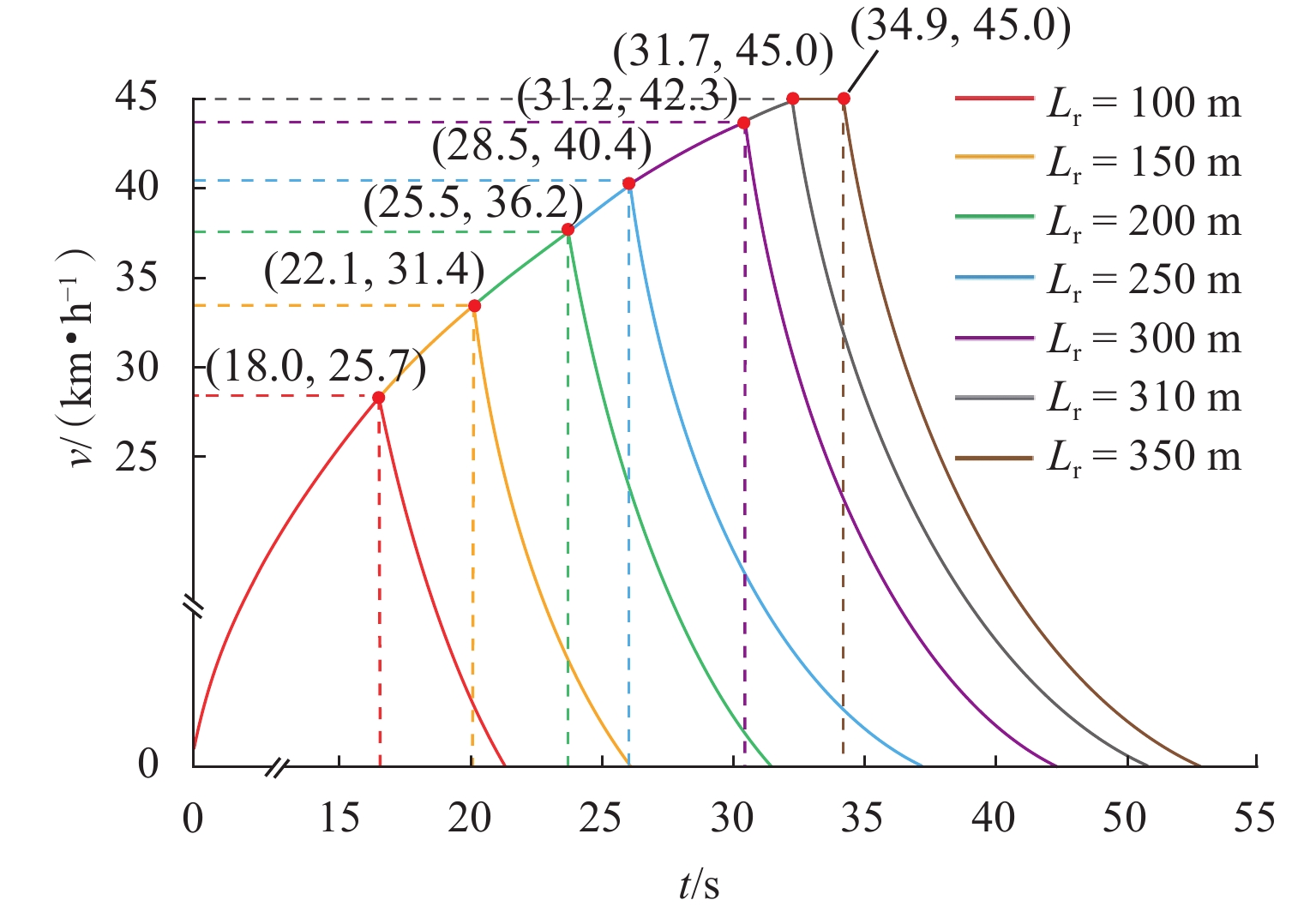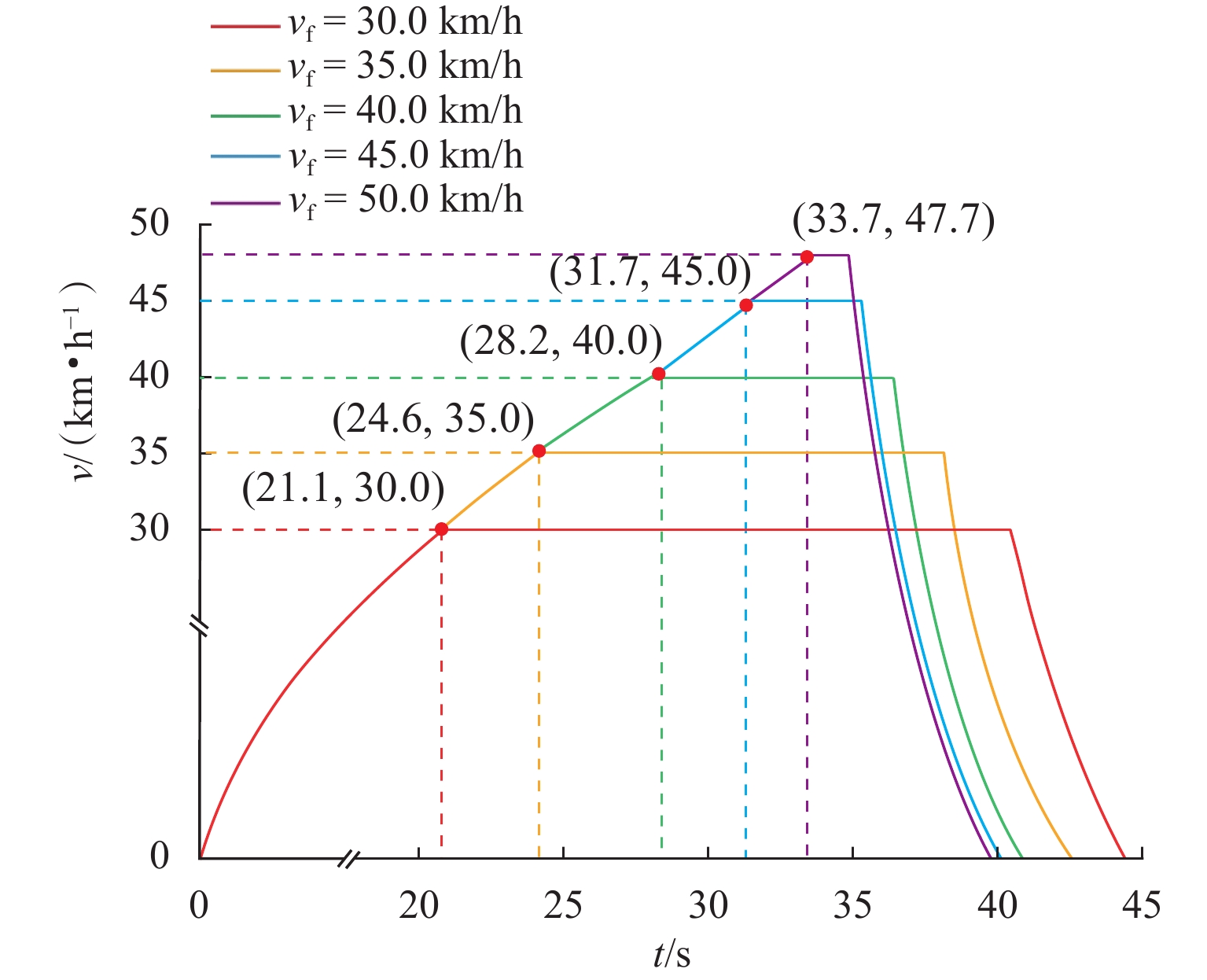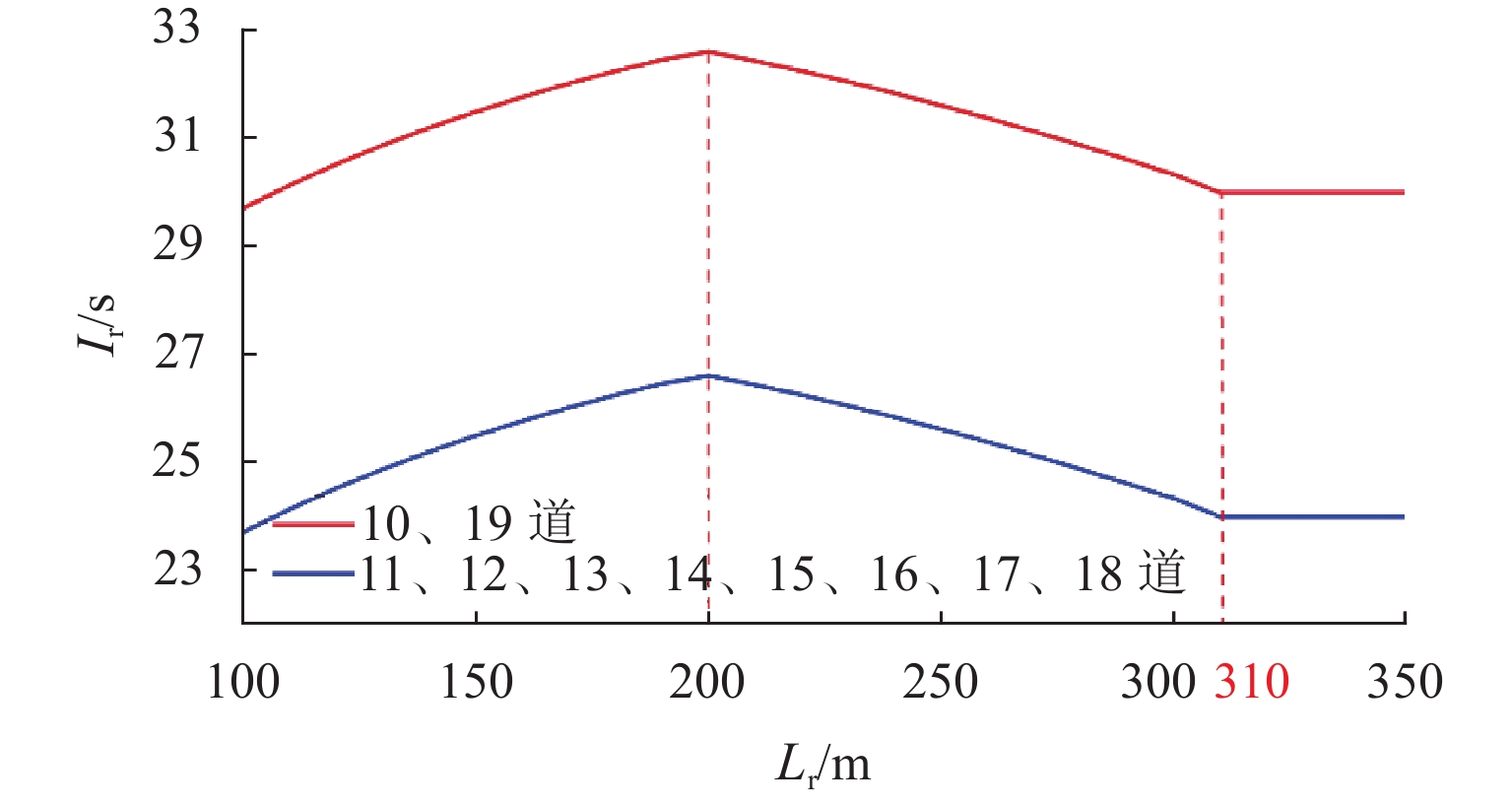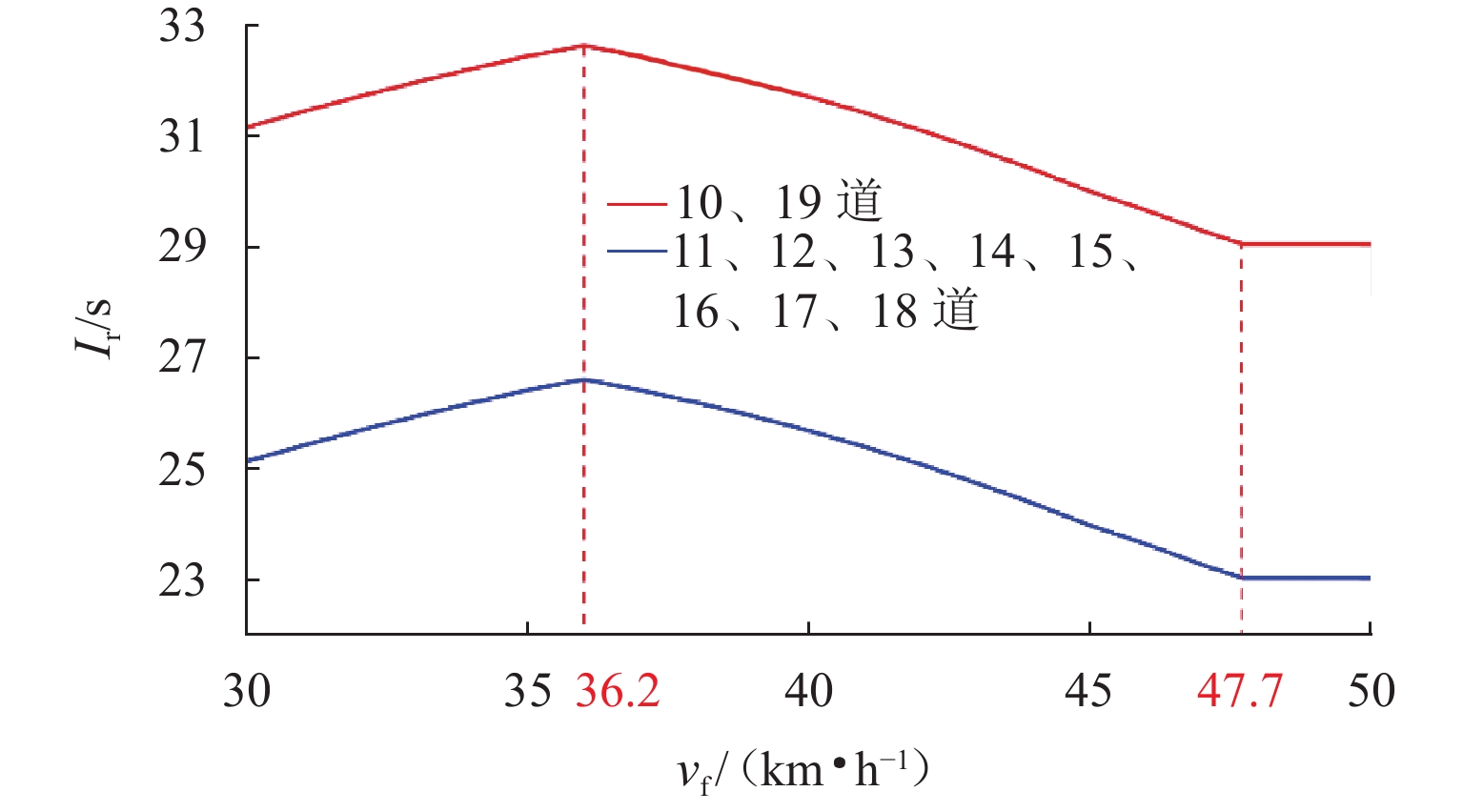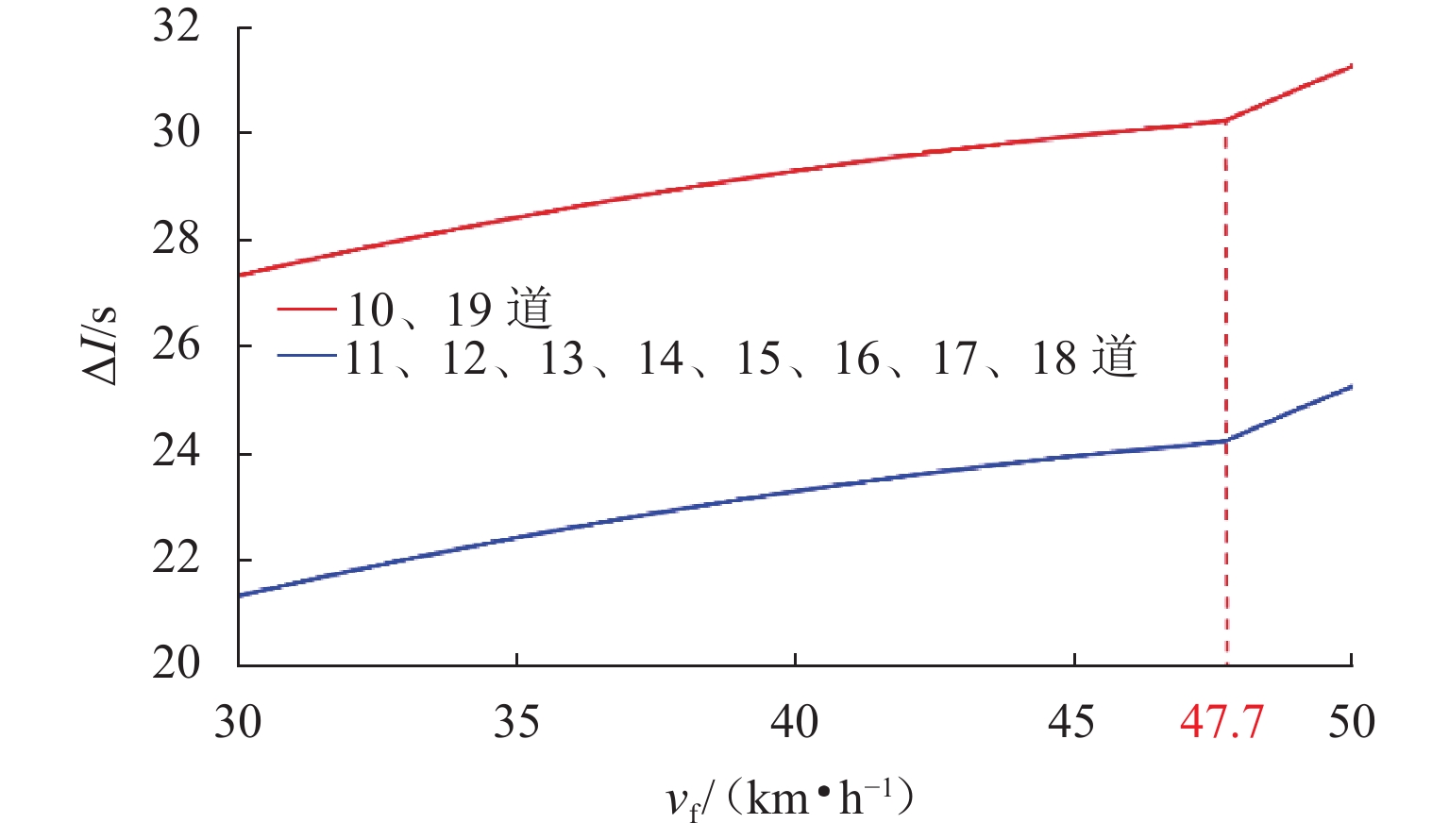Method for Compressing Departure Tracking Interval of High-Speed Trains Based on Pre-departure Strategy
-
摘要:
出发追踪间隔时间是限制列车实现3 min追踪运行的主要瓶颈之一,压缩出发追踪间隔时间可有效提高线路通过能力. 首先,分析高速列车出发追踪运行过程,提出在出站信号机内侧一定距离设置预发车信号机,使列车在出站信号机开放时具有一定初速度且剩余出站距离缩短;并设计预发车过程的“故障导向安全”原则以确保列车不冒进出站信号机;然后,在分析影响压缩出发追踪间隔时间因素的基础上,研究不同预发车方案下的列车控车模式曲线;最后,以上海虹桥站高速场为例进行仿真验证. 研究表明:该方法能压缩列车出发追踪间隔时间,压缩效果随预发车距离的增大呈现先上升后下降的趋势;在到发线有效长可提供200 m预发车距离时,最大可压缩列车出发追踪间隔时间26 s以上.
Abstract:The departure tracking interval is one of the main bottlenecks that limit the 3-minute tracking operation of trains, and compressing the departure tracking interval can effectively improve line capacity. The departure tracking process of high-speed trains was first analyzed, and a pre-departure annunciator was set at a certain distance inside the outbound annunciator, making the train have a certain initial speed and shortening the remaining outbound distance when the outbound annunciator was open. At the same time, the principle of “failure-oriented safety” for the pre-departure process was put forward to ensure that the train did not cross the outbound annunciator. Then, based on the analysis of factors affecting the compression of departure tracking interval, the curves of train control mode under different pre-departure schemes were studied. Finally, the high-speed yard of Shanghai Hongqiao Station was studied, and the results show that the departure tracking interval can be compressed by the proposed method. The compression effect increases first and then decreases with the increase in the pre-departure distance, and the maximum compressible departure tracking interval can be more than 26 s if the pre-departure distance reaches 200 m of the effective lengths of the arrival-departure track.
-
随着我国高速铁路网络的不断完善,高速铁路客流需求持续增长,部分线路通过能力逐渐达到饱和,难以满足实际客流需要,繁忙干线运输能力供不应求的问题亟待解决. 列车追踪间隔时间是制约线路通过能力提升的关键因素,压缩列车追踪间隔时间有利于提高列车运行效率和线路运输能力.
根据对我国高速铁路列车出发追踪间隔时间的检算,部分大型车站实现3 min出发追踪间隔存在明显困难,是列车追踪间隔时间压缩的主要瓶颈之一 [1].
国内外许多学者对列车追踪间隔时间的压缩策略进行了研究,并已取得丰硕的研究成果. 文献[2]根据不同的速度限制条件将区间划分为若干个区段,设计了基于差分进化和模拟退火的混合进化算法求解各区段的最优列车运行轨迹,从而优化列车区间追踪间隔时间. 充分考虑线路条件、阻力系数等因素的干扰,文献[3]建立了数学优化模型,根据列车运行实时信息求解最优列车区间追踪间隔时间;文献[4]对轨道坡度进行拟合化简,以多阶段决策的方式实时计算并优化高速铁路列车的制动距离以压缩追踪间隔时间. 基于移动闭塞系统的应用优势,文献[5-6]提出了移动闭塞制式下的列车速度控制策略以压缩列车追踪间隔时间;文献[7]通过对高速列车各类追踪间隔时间的检算,指出列车追踪间隔时间主要受到达追踪间隔的限制,其次是出发追踪间隔. 针对到达追踪间隔时间,文献[8]提出在分段解锁条件下,可通过优化追踪运行列车的到发线运用方案压缩列车到达追踪间隔时间;文献[9]通过在接近车站的指定闭塞分区实施速度控制,缩短列车进站前的制动距离,达到压缩列车到达追踪间隔时间的效果;文献[10]建立了列车运行时空轨迹优化的混合整数线性规划模型,在尽量小的区间运行时间增加代价下压缩列车到达追踪间隔时间;文献[11]研究了线路闭塞分区布局的优化方法,从而压缩列车到达追踪间隔时间. 针对出发追踪间隔时间,文献[12]提出可通过提高车站咽喉区道岔限速的方式提高列车出站速度,进而压缩列车出发追踪间隔时间;文献[13]通过对出发追踪间隔时间影响因素分析,提出降低UUS码开放要求、采用CTCS-3级列控模式发车、增设总出站信号机实现进路分段办理等出发追踪间隔时间压缩方案;文献[14]通过仿真验证了调度集中(centralized traffic control,CTC)系统优化和线路设计改造是压缩出发追踪间隔时间的有效措施.
现有研究中,在列车到达追踪间隔时间压缩方面,到发线运用优化、区间速度控制等方式均能够以较小的代价达到压缩效果;而既有出发追踪间隔时间的压缩方法大多涉及到车站或动车组等的设备升级,实施成本高、研发与推广应用周期长,且压缩效果有限. 因此,研究不依赖于设备升级的出发追踪间隔时间压缩方法对进一步压缩列车追踪间隔时间、提高列车运行效率具有重要意义.
针对出发追踪间隔时间压缩问题,本文提出预发车的概念. 通过在出站信号机内侧设置预发车信号机,在保证安全的基础上,出站信号机正式开放前一段很短的时间内开放预发车信号机,允许列车在最高限速下合理提前启动,加快列车出站过程,从而压缩出发追踪间隔时间;为解决该方法的安全隐患,研究基于故障导向安全原则的预发车过程安全保障策略,并分析预发车信号机的开放时机和压缩出发追踪间隔时间的效果;以上海虹桥站高速场为例,通过仿真实验验证该方法的有效性
1. 列车出发追踪间隔时间概念
高速铁路列车出发追踪间隔时间指自前行列车由车站发出时起,至由该站再发出另一列同方向列车时止的最小间隔时间,包括前行列车从车站出发至出清一离去的时间和为后行列车办理出发作业的时间[15].
根据铁总运[2015] 105号《CRH系列动车组操作规则》(TG/JW105—2015)[16]对高速铁路车站发车作业的规定,列车在越过出站信号机前,按CTCS-2级列控系统的部分监控模式行车,列车运行速度不得超过列控系统发车控制速度vf(45.0 km/h);列车头部越过出站信号机后,列控系统转为完全监控模式,列车运行速度不超过咽喉区限速vy(18号道岔为80.0 km/h);待出清反向进站信号机后,方可继续提速到线路允许运行速度[1]. 因此,列车出发追踪运行过程如图1所示. 图中:t为时间,s;v为速度,m/s;If为标准发车作业的出发追踪间隔时间,s;Lb为列车停车标至出站信号机的距离,m;Ly为车站咽喉区长度,m;Ll为第一离去闭塞分区长度,m;Lt为列车长度,m;Le为办理后车出发作业时间内前行列车的走行距离,m.
由图1可知,前行列车由车站发出并出清第一离去闭塞分区后,CTC为后行列车办理发车进路,并开放出站信号机,后行列车司机确认信号机开放后,启动列车并由车站发出. 行列车出发追踪间隔时间如式(1)所示.
If=Lb+Ly+Ll+Ltvc+te, (1) 式中:vc为列车出站过程中的平均运行速度,m/s;te为办理列车出发作业所需时间,包括排列出发进路所需时间、司机确认信号所需时间和从司机动作到列车启动所需时间,s.
2. 基于预发车的出发追踪间隔时间压缩方法
由于动车组性能和旅客舒适度的问题,列车在发车过程中加速度有限,从而站内走行速度较低,出发追踪间隔时间较长. 基于此,若在明确出站信号机具体开放时间的情况下,适当允许列车提前启动,在发车进路办理的同时,利用到发线上列车头部至出站信号机间的剩余距离使列车提前加速,将有望在压缩列车出发追踪间隔时间方面取得效果.
2.1 预发车定义
标准发车作业中,司机按出站信号机显示行车,出站信号机开放后方可启动列车. 为压缩出发追踪间隔时间,在到发线上恰当位置设置轨旁预发车信号机,使列车在预发车信号机内侧停车. 在出站信号机开放前的某一适当时机,先开放预发车信号机,指示列车提前启动,从而在办理发车进路的同时进行列车启动及加速,使得出站信号机开放时,列车已具有一定的初速度且剩余出站行驶距离缩短,达到压缩出发追踪间隔时间的效果. 为后文叙述方便,将预发车信号机开放至出站信号机开放这段时间内列车提前启动的过程称为列车预发车过程,如图2所示. 该过程设计的安全保障措施将在后文进行具体分析. 图中:Lq为牵引走行距离,m;Lr为预发车距离,m;tq为牵引走行时间,s;ta为列车在出站信号机开放前提前启动的运行时间,s;Lu为匀速走行距离,m;tu为匀速走行时间,s.
基于上述原理,办理列车预发车时需满足如下条件:
1) 明确出站信号机的具体开放时间,以便推算预发车信号机的开放时机,列车在预发车信号机开放后提前启动,并且出站信号机开放前不得越过出站信号机;
2) 到发线上预发车信号机至出站信号机间有一定的剩余距离,以保证有足够的距离供列车提前启动及加速.
2.2 理想情况下的列车预发车过程
理想化情况下,在出站信号机开放前的某一时刻,令预发车信号机先行开放,列车提前启动并在到发线上运行一段时间后,出站信号机开放,此时列车头部刚好以一定速度到达出站信号机位置,从而既保证了列车在出站信号开放后才越过出站信号机,又使得列车能够在出站信号机开放前加速到其最大可能初速度,实现列车出发追踪间隔时间的最大化压缩.
将预发车信号机至出站信号机的距离称为预发车距离Lr,则根据预发车距离的不同,列车预发车过程存在图2所示的2种可能性:
1) 预发车距离不足. 列车在出站信号机开放前无法加速到vf,则列车预发车过程只包含牵引工况,如式(2)所示.
{Lq=Lr,tq=ta. (2) 2) 预发车距离富余. 列车在出站信号机开放前能够加速到vf,则列车预发车过程由牵引和匀速工况共同构成,如式(3)所示.
{Lq+Lu=Lr,tq+tu=ta. (3) 2.3 基于安全防护标识的预发车安全保障策略
在Lr一定的情况下,理想化的预发车过程能够实现列车出发追踪间隔时间的最大化压缩,但存在一定的安全隐患. 车站实际作业过程中,由于设备性能或人员操作等因素的影响,出站信号机可能无法及时开放,此时按照图2所示办理预发车将造成列车冒进出站信号机,从而影响列车运行安全.
为避免上述事故发生,结合准移动闭塞模式的故障导向安全原理,在出站信号机之前设置一定的安全冗余,若出现出站信号机未能按时开放的情况,保证列车有足够距离采取制动措施,并在出站信号机前重新停车. 因此,为确保列车预发车过程的作业安全,在预发车信号机与出站信号机之间的适当位置设置安全防护标识,安全防护标识至出站信号机的距离应足以使列车从当前速度制动至停车,如图3所示. 基于安全防护标识,为预发车过程设计安全保障策略,保障预发车作业的安全,故障导向安全原则下的预发车过程将在后文进行具体描述.
若列车运行至安全防护标识时,出站信号机已经开放,则列车可以按照预发车作业流程继续运行;若列车运行至安全防护标识时出站信号机还未开放,为保证列车作业安全,必须中断列车预发车过程,将预发车过程被中断的情况称为预发车失败. 预发车失败时的处置方法如下:列车到达安全防护标识时,出站信号机未开放,列车开始制动并在出站信号机前停车,待出站信号机开放后,列车方可再次启动并完成出站作业过程.
需要注意的是,在预发车失败的情形下,列车在出站信号机内侧制动停车并等待出站信号机开放后再次启动,与标准发车作业相比,出站信号机开放后列车的剩余出站运行距离缩短Lb,Lb为制动走行距离,m. 因此,即使是在预发车失败的情形下,其列车出发追踪间隔时间较标准发车作业仍有所减小,不会造成车站通过能力的损失.
2.4 故障导向安全原则下的列车预发车过程
参照准移动闭塞的故障导向安全原则,设计故障导向安全原则下的预发车过程. 从预发车信号机开放至出站信号机开放这段时间内,列车运行速度目标点应为出站信号机,目标速度为 0,则列车在出站信号机前的控车模式曲线按预发车距离的不同分为图4所示的2种情况. 图中:vs为列车运行至安全防护标识的速度,km/h;Ls为安全防护标识至出站信号机的距离,m;tb为制动走行所花费的时间,s.
1) 预发车距离不足. 列车在到达安全防护标识时无法加速到vf,此时列车控车模式曲线包含牵引和制动曲线;
2) 预发车距离富余. 列车在到达安全防护标识时能够加速到vf,此时列车控车模式曲线由牵引、巡航、制动曲线3个部分构成.
根据列车出发作业的要求,列车应不减速通过出站作业进路. 基于此,办理列车预发车时,应保证列车能够不减速通过出站信号机,即列车运行至安全防护标识时,发车进路已办理完成且出站信号机处于开放状态. 因此,将办理列车预发车的条件总结如下:
1) 预发车距离不足
{vs<vf,Lb⩽ (4) 2) 预发车距离富余
\left\{\begin{array}{l}v_{\mathrm{s}}=v_{\mathrm{f}}, \\ L\mathrm{_b}\leqslant L\mathrm{_s}, \\ L\mathrm{_q}+L\mathrm{_u}+L\mathrm{_b}\leqslant L\mathrm{_r}, \\ t_{\mathrm{a}}\leqslant t\mathrm{_q}+t_{\mathrm{u}}.\end{array}\right. (5) 式(4)~(5)中,关于距离的表达式使列车采取制动时能够在出站信号机前停车,从而保证列车不冒进出站信号机;关于时间的表达式使出站信号机在列车到达安全防护标识前开放,从而保证列车不减速通过出站信号机. 两者共同作用可确保预发车过程中列车的安全运行和出发作业的正常接续. 为尽可能大地压缩列车出发追踪间隔时间, t\mathrm{_a} 应取其最大值 t\mathrm{_q} 或 t_{\mathrm{q}}+t_{\mathrm{u}} ,即式(4)~(5)中的不等式均取到等号.
根据式(4)~(5)确定 t\mathrm{_a} 后,预发车信号机的开放时机即可由式(6)推算得到.
T\mathrm{_r}=T\mathrm{_d}-t_{\mathrm{a}}-t_{\mathrm{s}}-t_{\mathrm{m}}, (6) 式中: T\mathrm{_r} 为预发车信号机的开放时刻; T\mathrm{_d} 为出站信号机的开放时刻; t\mathrm{_s} 为司机确认信号所需时间, \mathrm{s} ; t\mathrm{_m} 为从司机动作到列车启动所需时间, \mathrm{s} .
从理论出发,列车出发进路排列完成后,出站信号机即可开放,因此出站信号机的开放时机可由式(7)得出.
T_{\mathrm{d}}=T_{\mathrm{f}}+t\mathrm{_e}-t\mathrm{_s}-t\mathrm{_m}, (7) 式中: T\mathrm{_f} 为开始为列车排列出发进路的时刻.
3. 基于预发车的出发追踪间隔时间压缩效果及其影响因素分析
3.1 基于预发车的出发追踪间隔时间压缩效果
列车凭预发车信号机显示提前启动时,CTC的发车控制流程如图5所示.
1) 前车出清一离去闭塞分区,CTC开始为后行列车办理列车出发作业,采用式(7)计算 {T}_{{\mathrm{d}}} ;
2) 在 {T}_{{\mathrm{d}}} 满足式(6)时,开放预发车信号机,后行列车由静止开始启动,列车运行速度目标点为出站信号机,目标速度为0;
3) 后行列车出发作业办理完成,开放出站信号机,列车运行速度目标点前移至其追踪列车所在闭塞分区入口,列车继续加速,目标速度为 {v}_{{\mathrm{y}}} ;
4) 后行列车出清反向进站信号机,继续加速,目标速度为区间限速;
5) 后行列车出清一离去闭塞分区,出站作业过程结束.
根据图5,基于预发车信号的出发追踪间隔时间 I\mathrm{_{rd}} 为
I\mathrm{_{rd}}=\frac{L_{\mathrm{s}}+L\mathrm{_y}+L\mathrm{_l}+L\mathrm{_t}}{v\mathrm{_{rc}}}+t\mathrm{_e}, (8) 式中: v\mathrm{_{rc}} 为列车以 v\mathrm{_s} 为初速度由安全防护标识运行至出清一离去闭塞分区的平均速度,m/s.
结合式(1)、(8),得到采用预发车信号法发车的出发追踪间隔时间压缩量为
I\mathrm{_r }= \frac{L\mathrm{_b }+ L\mathrm{_y }+ L\mathrm{_l}+L\mathrm{_t}}{v\mathrm{_c}}-\frac{L\mathrm{_s}+L\mathrm{_y}+L\mathrm{_l}+L\mathrm{_t}}{v_{\mathrm{rc}}}. (9) 由式(9)可知,基于预发车法压缩出发追踪间隔的效果具体体现在:出站信号机开放后,列车具有初速度 v\mathrm{_s} ,从而平均速度 v\mathrm{_{rc}} 相较 v\mathrm{_c} 有所增加,且剩余出站运行距离缩短 L\mathrm{_b}-L_{\mathrm{s}} . 因此, I\mathrm{_r} 可表示为
{I}_{{\mathrm{r}}}={I}_{{\mathrm{v}}} + {I}_{{\mathrm{L}}}, (10) 式中: {I_{\mathrm{v}}}为初速度增大带来的出发追踪间隔时间压缩量,s; {I_{\mathrm{L}}}为剩余出站运行距离缩短带来的出发追踪间隔时间压缩量,s.
易知, {I_{\mathrm{v}}}随 {v}_{{\mathrm{s}}} 增大而增大, {I_{\mathrm{L}}}随 {L}_{s} 增大而减小.
3.2 出发追踪间隔时间压缩效果的影响因素分析
根据图4所示的控车模式曲线可知,出站信号机开放时列车的初速度与剩余出站运行距离由 {L}_{{\mathrm{r}}} 和 {v}_{{\mathrm{f}}} 决定,因此出发追踪间隔时间压缩效果主要受 {L}_{{\mathrm{r}}} 和 {v}_{{\mathrm{f}}} 的影响,本节对2个影响因素展开具体分析,研究不同 {L}_{{\mathrm{r}}} 和 {v}_{{\mathrm{f}}} 取值下,控车模式曲线的变化.
3.2.1 预发车距离
为满足旅客乘降需求,高速列车停车位置应保证列车全长在旅客站台长度范围内,故如图6所示,列车在到发线上的可行停车范围为:列车头部恰好与旅客站台出站端平齐至列车尾部恰好与旅客站台进站端平齐,则预发车信号机的设置位置应满足式(11).
{L}_{{\mathrm{x}}}\leqslant {L}_{{\mathrm{r}}}\leqslant {L}_{{\mathrm{x}}} + {L}_{{\rm{z}}}-{L}_{{\mathrm{t}}}, (11) 式中: {L}_{{\mathrm{x}}} 为出站信号机至旅客站台出站端的距离,m,一般为100 m; {L}_{{\rm{z}}} 为站台长度,m,一般为450 m.
根据高速铁路设计规范对出站信号机布置的要求[17],在到发线长度有限的情况下,16节编组列车可行的 {L}_{{\mathrm{r}}} 较小且变化空间有限,因此本文以8节编组的CRH 380B型动车组为例展开研究,其 {L}_{{\mathrm{r}}} 的取值范围为100~350 m,如图7所示.
令 {v}_{{\mathrm{f}}} 不变(取标准值45.0 km/h)、 {L}_{{\mathrm{r}}} 由100 m逐渐增加至350 m,采用牵引计算检算列车在不同 {L}_{{\mathrm{r}}} 下的控车模式曲线,得到图7所示结果. 如图中 {L}_{{\mathrm{r}}} =100 m的红色曲线,其 {t}_{{\mathrm{a}}} =18.1 s, {v}_{{\mathrm{s}}} =25.7 km/h,意为列车在预发车信号开放时开始启动并加速,由于必须在出站信号机前停车,其加速至25.7 km/h时到达安全防护标识,若此时出站信号机未开放则必须开始减速直至0,即. 随着 {L}_{{\mathrm{r}}} 的增加,列车可加速到的最大速度也会有所增加,但不超过45.0 km/h.
从图7的列车速度曲线可知, {L}_{{\mathrm{r}}} =310 m时,列车到达安全防护标识时,刚好加速到 {v}_{{\mathrm{f}}} ;当 {L}_{{\mathrm{r}}} < 310 m时,列车控车模式曲线对应于预发车距离不足的情况, {v}_{{\mathrm{s}}} 、 {L}_{{\mathrm{s}}} 均随 {L}_{{\mathrm{r}}} 增加;当 {L}_{{\mathrm{r}}} > 310 m 时,列车控车模式曲线对应于预发车距离富余的情况, {v}_{{\mathrm{s}}} 、 {L}_{{\mathrm{s}}} 不再随 {L}_{{\mathrm{r}}} 的增大而变化,因此,继续增加 {L}_{{\mathrm{r}}} 不再对出发追踪间隔时间压缩效果 {I}_{{\mathrm{r}}} 产生影响, {v}_{\mathrm{{f}}} 成为唯一限制因素.
3.2.2 列控系统发车控制速度
本节研究不同 {v}_{{\mathrm{f}}} (30.0~50.0 km/h)下,列车可能出现的控车模式曲线. 根据上文可知,列车由于距离不够无法在安全防护标识前加速到 {v}_{{\mathrm{f}}} 时,预发车过程控车模式曲线不受 {v}_{{\mathrm{f}}} 影响,因此到发线上应预留足够的可供列车加速的空间,综合考虑车长与站台长度后,本节取 {L}_{{\mathrm{r}}} 为350 m.
令 {L}_{{\mathrm{r}}} 不变(350 m), {v}_{{\mathrm{f}}} 由30 km/h逐渐增加至50 km/h,采用牵引计算检算列车在不同 {v}_{{\mathrm{f}}} 下的控车模式曲线,结果如图8所示. 如图中 {v}_{{\mathrm{f}}} =30.0 km/h的红色曲线,其 {t}_{{\mathrm{q}}} =21.1 s, {v}_{{\mathrm{s}}} =30.0 km/h,意为列车在预发车信号开放时开始启动并加速,加速21.1 s后便达到了列控系统发车控制速度,即 {v}_{{\mathrm{s}}} = {v}_{{\mathrm{f}}} =30.0 km/h,此后转为匀速运行至安全防护标识,若此时出站信号机未开放则必须开始减速直至0. 随着 {v}_{{\mathrm{f}}} 的增加, {v}_{{\mathrm{s}}} 有所增加,直到47.7 km/h.
如图8所示, {v}_{{\mathrm{f}}} =47.7 km/h时,列车到达安全防护标识时刚好加速到 {v}_{{\mathrm{f}}} ;当 {v}_{{\mathrm{f}}} 在47.7 km/h以内时,列车控车模式曲线对应于预发车距离富余的情况,随着 {v}_{{\mathrm{f}}} 的增加,安全速度 {v}_{{\mathrm{s}}} 和安全防护距离 {L}_{{\mathrm{s}}} 均呈现增大的趋势;当 {v}_{{\mathrm{f}}} > 47.7 km/h时,列车控车模式曲线对应于预发车距离不足的情况, {v}_{{\mathrm{s}}} 、 {L}_{{\mathrm{s}}} 均不再随 {v}_{{\mathrm{f}}} 的变化而变化,从而基于预发车信号的出发追踪间隔时间压缩效果 {I}_{{\mathrm{r}}} 不再受 {v}_{{\mathrm{f}}} 影响.
要注意的是,根据式(1)可知,在 {v}_{{\mathrm{f}}} 改变的情况下, {v}_{{\mathrm{f}}} 取值相对于标准值的变化将影响列车出站运行速度,进而影响出发追踪间隔时间. 因此,此时出发追踪间隔时间的整体变化量包含两部分,即
\Delta I=I\mathrm{_r}+\Delta I_{\mathrm{fk}}=I\mathrm{_v}+I\mathrm{_L}+\Delta I\mathrm{_{fk}}, (12) 式中:\Delta I为改变 {v}_{{\mathrm{f}}} 的预发车整体出发追踪间隔时间压缩量,s; \Delta I\mathrm{_{fk}} 为 {v}_{{\mathrm{f}}} 取值相对于标准值变化造成的出发追踪间隔时间变化量,s.
易知, \Delta I\mathrm{_{fk}} 与 {v}_{{\mathrm{f}}} 同增,且当 {v}_{{\mathrm{f}}} < 45 km/h时, \Delta I\mathrm{_{fk}} < 0; {v}_{{\mathrm{f}}} > 45 km/h时, \Delta I\mathrm{_{fk}} > 0.
根据上述分析可知,不论增大 {L}_{{\mathrm{r}}} 或增大 {v}_{{\mathrm{f}}} ,\Delta {I_{\mathrm{v}}}均随之增大,\Delta {I_{\mathrm{L}}}均随之减小,从而 {I}_{{\mathrm{r}}} 随 {L}_{{\mathrm{r}}} 或 {v}_{{\mathrm{f}}} 的变化趋势难以由控车模式曲线的变化直接得知,将在算例中进行具体分析.
4. 出发追踪间隔时间压缩效果仿真分析
4.1 仿真实验数据及方案
本文以图9所示的上海虹桥站高速场上行车场为例,选取8节编组的CRH380B型动车组进行列车出发追踪运行仿真实验,计算分析不同列车预发车情景下的出发追踪间隔压缩效果,并提出合理的出发追踪间隔时间压缩方案. 具体的各到发线发车进路长度、发车作业时间等参数标准取值见表1.
表 1 相关参数Table 1. Related parameters股道 发车进路
长度/m{L}_{{\mathrm{b}}} /m {t}_{{\mathrm{e}}} /s {v}_{{\mathrm{f}}} /
(km•h−1){v}_{{\mathrm{y}}} /
(km•h−1)10 2607 290 51.0 45.0 80.0 11 2903 215 12 2903 215 13 2871 215 14 2871 215 15 2879 215 16 2879 215 17 2936 215 18 2936 215 19 2551 290 为研究发追踪间隔时间压缩效果随各影响因素的变化规律,本文采用控制变量法设计如下2组实验:
1) 实验1:在给定的 {v}_{{\mathrm{f}}} 下,研究预发车对列车出发追踪间隔时间的压缩效果,即 {I}_{{\mathrm{r}}} 随 {L}_{{\mathrm{r}}} 的变化趋势;
2) 实验2:在给定的 {L}_{{\mathrm{r}}} 下,研究改变 {v}_{{\mathrm{f}}} 的预发车对列车出发追踪间隔时间的压缩效果,即 {I}_{{\mathrm{r}}} 、\Delta I随 {v}_{{\mathrm{f}}} 的变化趋势.
上述实验涉及3种情景下的出发追踪间隔时间计算,为便于后文描述,此处对其进行统一定义:
1) 标准发车作业:列车停在停车标内侧,在出站信号机开放后启动, {L}_{{\mathrm{b}}} 与 {v}_{{\mathrm{f}}} 按照表1取值;
2) 标准发车作业对照作业:列车停在停车标内侧,在出站信号机开放后启动, {L}_{{\mathrm{b}}} 按照表1取值, {v}_{{\mathrm{f}}} 按照实验方案取值;此作业中 {L}_{{\mathrm{b}}} 与标准发车作业相应参数取值一致且列车均在出站信号机开放后启动,从而与标准发车作业形成对照,以便计算 {v}_{{\mathrm{f}}} 改变对出发追踪间隔时间的影响 \Delta I\mathrm{_{fk}} ;
3) 预发车作业:列车停在预发车信号机内侧,在预发车信号机开放后提前启动, {L}_{{\mathrm{r}}} 与 {v}_{{\mathrm{f}}} 按照实验方案取值.
具体而言,实验1涉及标准发车作业和预发车作业2种情景,实验2涉及标准发车作业、标准发车作业对照作业和预发车作业3种情景,具体应用过程将在后文实验中阐述.
4.2 预发车距离对出发追踪间隔时间压缩效果的影响
本节研究给定 {v}_{{\mathrm{f}}} 下,不同 {L}_{{\mathrm{r}}} 对出发追踪间隔时间压缩效果的影响. 令 {v}_{{\mathrm{f}}} 取45 km/h、 {L}_{{\mathrm{r}}} 由 100 m逐渐增加至350 m,进行实验1. 对车场内全部到发线,计算在不同的 {L}_{{\mathrm{r}}} 取值下,标准发车作业和预发车作业2种情景下的出发追踪间隔时间,从而采用式(9)即可计算 {I}_{{\mathrm{r}}} ,得到 {I}_{{\mathrm{r}}} 随 {L}_{{\mathrm{r}}} 的变化曲线,如图10所示.
根据对图10的分析,发现如下现象与结论:
1) 对于10道和19道,其出发追踪间隔时间压缩量 {I}_{{\mathrm{r}}} 介于29~32 s;11~18道的 {I}_{{\mathrm{r}}} 则介于23~26 s.
2) 10道和19道、11~18道分别具有相同的变化曲线,产生这一现象的原因为:针对10道和19道,根据表1可知在标准发车作业中,2条到发线上列车停车标至出站信号机的距离 {L}_{{\mathrm{b}}} 相同,从而在相同的预发车情景下,2条到发线 {I}_{{\mathrm{r}}} 的计算式(9)中各部分均相同,即 {I}_{{\mathrm{r}}} 随 {L}_{{\mathrm{r}}} 的变化曲线一致;11~18道同理.
3) {I}_{{\mathrm{r}}} 总体上呈现先上升后下降的趋势,并在 {L}_{\mathrm{{r}}} =200 m时达到峰值,此时列车预发车过程的 {v}_{{\mathrm{s}}} =36.2 km/h, {L}_{{\mathrm{s}}} =73 m. 当 {L}_{{\mathrm{r}}} ≤ 200 m时, {I}_{{\mathrm{r}}} 逐渐上升,表明当 {v}_{{\mathrm{s}}} ≤ 36.2 km/h, {L}_{{\mathrm{s}}} ≤ 73 m时,\Delta {I_{\mathrm{v}}}增大的幅度大于\Delta {I_{\mathrm{L}}}减小的幅度; {L}_{{\mathrm{r}}} > 200 m时的情况则与之完全相反.
4) 当 {L}_{{\mathrm{r}}} 超过310 \mathrm{m} 后, {v}_{{\mathrm{s}}} 、 {L}_{{\mathrm{s}}} 保持不变,从而 {I}_{{\mathrm{r}}} 不再随 {L}_{{\mathrm{r}}} 变化,这与3.2.1节的分析是一致的.
4.3 列控系统发车控制速度对出发追踪间隔时间压缩效果的影响
本节研究给定 {L}_{{\mathrm{r}}} 下,不同 {v}_{{\mathrm{f}}} 对出发追踪间隔时间压缩效果的影响. 令 {L}_{{\mathrm{r}}} =350 m, {v}_{{\mathrm{f}}} 由30 km/h逐渐增加至50 km/h,进行实验2. 对车场内全部到发线,计算在不同的 {v}_{{\mathrm{f}}} 取值下,标准发车作业、标准发车作业对照作业和预发车作业3种情景下的出发追踪间隔时间,其中标准发车作业与标准发车作业对照作业出发追踪间隔时间之间的差值,等同于 {v}_{{\mathrm{f}}} 取值相对于标准值变化造成的出发追踪间隔时间变化量 \Delta I_{\mathrm{fk}} . 标准发车作业与预发车作业出发追踪间隔时间之间的差值,且等同于改变 {v}_{{\mathrm{f}}} 的预发车作业造成的出发追踪间隔时间变化量\Delta I. 从而采用式(12)即可计算 {I}_{{\mathrm{r}}} ,得到 {I}_{{\mathrm{r}}} 随 {v}_{{\mathrm{f}}} 的变化曲线如图11所示.
根据对图11的分析,发现如下现象与结论:
1) 10道和19道的出发追踪间隔时间压缩量 {I}_{{\mathrm{r}}} 介于29~32 s,11~18道介于23~26 s.
2) 当 {v}_{{\mathrm{f}}} < 47.7 km/h时,随着 {v}_{{\mathrm{f}}} 的增加, {I}_{{\mathrm{r}}} 先上升后下降,并在 {v}_{{\mathrm{f}}} =36.2 km/h时达到峰值. 原因在于 {L}_{{\mathrm{r}}} 取350 m的情况下,当 {v}_{{\mathrm{f}}} ≤ 36.2 km/h时, {v}_{{\mathrm{s}}} ≤ 36.2 km/h, {L}_{{\mathrm{s}}} ≤ 73 m; {v}_{{\mathrm{f}}} > 36.2 km/h 时, {v}_{{\mathrm{s}}} > 36.2 km/h, {L}_{{\mathrm{s}}} > 73 m. 因此根据图10的结论3, {v}_{{\mathrm{f}}} ≤ 36.2 km/h时, {I_{\mathrm{v}}}增大的幅度大于 {I_{\mathrm{L}}}减小的幅度,从而 {I}_{{\mathrm{r}}} 总体上呈现上升的趋势; {v}_{{\mathrm{f}}} > 36.2 km/h时, {I_{\mathrm{v}}}增大的幅度小于 {I_{\mathrm{L}}}减小的幅度,从而 {I}_{{\mathrm{r}}} 总体上呈现下降的趋势.
3) 当 {v}_{{\mathrm{f}}} >47.7 km/h时, {I}_{{\mathrm{r}}} 不再随 {v}_{{\mathrm{f}}} 变化,这与3.2.2节分析得到的结论一致.
需要注意的是,虽然 {v}_{{\mathrm{f}}} =36.2 km/h时,预发车信号法压缩出发追踪间隔时间的效果 {I}_{{\mathrm{r}}} 最佳,但将导致 \Delta I\mathrm{_{fk}} <0,因此可能造成整体出发追踪间隔时间压缩量\Delta I的损失. 根据所得实验数据绘制\Delta I随 {v}_{{\mathrm{f}}} 的变化曲线,结果如图12所示.
1) 当 {v}_{{\mathrm{f}}} ≤ 36.2 km/h时,随着 {v}_{{\mathrm{f}}} 的增大, {I}_{{\mathrm{r}}} 、 \Delta I\mathrm{_{fk}} 均逐渐上升,因此\Delta I在二者的综合作用下呈现上升的趋势;当 {v}_{{\mathrm{f}}} > 36.2 km/h时,随着 {v}_{{\mathrm{f}}} 的增大, {I}_{{\mathrm{r}}} 逐渐下降, \Delta I\mathrm{_{fk}} 逐渐上升,而\Delta I仍保持上升的趋势,表明 \Delta I\mathrm{_{fk}} 上升的幅度大于 {I}_{{\mathrm{r}}} 下降的幅度.
2) 当 {v}_{{\mathrm{f}}} 超过47.7 km/h时, {I}_{{\mathrm{r}}} 不再变化,故\Delta I的变化仅与 \Delta I\mathrm{_{fk}} 有关; {v}_{{\mathrm{f}}} > 47.7 km/h时,\Delta I变化曲线具有更大的斜率,印证了上一结论的正确性.
3) 在允许改变 {v}_{{\mathrm{f}}} 的情况下,增大 {v}_{\mathrm{{f}}} 是提高出发追踪间隔时间压缩量\Delta I的有效措施.
4.4 实验结果分析
根据对前文实验结果的分析发现,凭预发车信号提前启动列车可有效压缩出发追踪间隔时间. 在一定的 {L}_{{\mathrm{r}}} 下,通过提高 {v}_{{\mathrm{f}}} 的方式调整预发车信号的开放时机和出站信号机开放时列车的初速度,有助于促进出发追踪间隔时间的压缩. 然而, {v}_{{\mathrm{f}}} 的取值需要结合多方面因素综合考量,提高 {v}_{{\mathrm{f}}} 可能涉及到列控系统的设备升级,因此后文不考虑改变 {v}_{{\mathrm{f}}} ,仅分析 {L}_{{\mathrm{r}}} 影响下的出发追踪间隔时间压缩效果.
由实验1可知, {L}_{{\mathrm{r}}} 取200 m时能够最大化压缩出发追踪间隔时间,对应的预发车方案为:在出站信号机内侧200 m处设置轨旁预发车信号机,并在出站信号机以内73 m处设置安全防护标识. 该方案下,基于预发车信号提前启动列车可压缩出发追踪间隔时间26~32 s.
在发车能力受限的大型高铁站,8节编组的列车到发线可利用的剩余长度往往足够,通过调整后能够预留出200 m的距离. 而对于16节编组的列车,由于列车长度的影响,在到发线有效长为650 m时,到发线上可供列车加速的剩余距离较短( {L}_{{\mathrm{r}}} <100 m),因此出发追踪间隔时间压缩效果有限;当到发线有效长超过855 m时,其 {L}_{{\mathrm{r}}} 最大可达到200 m,在此种情况下对16节编组列车采用预发车信号法发车能够取得较好的压缩效果.
5. 结 论
本文结合列车出发追踪运行过程,对出发追踪间隔时间的影响因素进行分析,并提出通过预发车信号指示列车提前启动以压缩出发追踪间隔时间的策略;在此基础上,分析不同预发车距离和列控系统发车控制速度值影响下,列车预发车过程的控车模式曲线;以上海虹桥站高速场上行车场为例的仿真实验表明所提出方法能够显著压缩列车出发追踪间隔时间,实验1中预发车距离为200 m的最佳预发车方案下,列车出发追踪间隔时间压缩量可达26~32 s.
明确出站信号机的确切开放时机是预发车作业成功办理的前提,本文根据列车出发作业办理时间计算出站信号机开放时机. 然而,受信联闭设备配置的影响,实际作业中各车站列车出发作业办理时间可能与标准中的定值存在差异,造成出站信号机的开放时间存在不确定因素. 因此,基于信联闭设备作业原理计算车站列车出发作业办理时间,进而推算出站信号机和预发车信号机开放时机,是后续研究中需要重点解决的问题.
-
表 1 相关参数
Table 1. Related parameters
股道 发车进路
长度/m{L}_{{\mathrm{b}}} /m {t}_{{\mathrm{e}}} /s {v}_{{\mathrm{f}}} /
(km•h−1){v}_{{\mathrm{y}}} /
(km•h−1)10 2607 290 51.0 45.0 80.0 11 2903 215 12 2903 215 13 2871 215 14 2871 215 15 2879 215 16 2879 215 17 2936 215 18 2936 215 19 2551 290 -
[1] 胡志垚. 进路分段办理压缩大型客站发车追踪间隔时间[J]. 交通科技与经济,2018,20(3): 23-27,65.HU Zhiyao. Compressing departure tracking interval of large passenger railway station with departure route subsection[J]. Technology & Economy in Areas of Communications, 2018, 20(3): 23-27,65. [2] SHANGGUAN W, YAN X H, CAI B G, et al. Multiobjective optimization for train speed trajectory in CTCS high-speed railway with hybrid evolutionary algorithm[J]. IEEE Transactions on Intelligent Transportation Systems, 2015, 16(4): 2215-2225. doi: 10.1109/TITS.2015.2402160 [3] YAN X H, CAI B G, NING B, et al. Moving horizon optimization of dynamic trajectory planning for high-speed train operation[J]. IEEE Transactions on Intelligent Transportation Systems, 2016, 17(5): 1258-1270. doi: 10.1109/TITS.2015.2499254 [4] GAO S L, ZHENG Y S. Adjustment of train interval time based on dynamic programming algorithm[C]// 2018 IEEE International Conference of Intelligent Robotic and Control Engineering (IRCE). Lanzhou: IEEE, 2018: 106-110. [5] WAGTER W. Block sections around stations under ETCS: the effect of the block layout on the headways at stations[D]. Enschede:Enschede University of Twente, 2019. [6] VIGNALI V, CUPPI F, LANTIERI C, et al. A methodology for the design of sections block length on ETCS L2 railway networks[J]. Journal of Rail Transport Planning & Management, 2020, 13: 100160.1-100160.22. [7] 田长海,张守帅,张岳松,等. 高速铁路列车追踪间隔时间研究[J]. 铁道学报,2015,37(10): 1-6.TIAN Changhai, ZHANG Shoushuai, ZHANG Yuesong, et al. Study on the train headway on automatic block sections of high speed railway[J]. Journal of the China Railway Society, 2015, 37(10): 1-6. [8] 彭其渊,王超宇,鲁工圆. 基于到发线运用方案的列车到达追踪间隔时间压缩方法及仿真研究[J]. 中国铁道科学,2020,41(2): 131-138.PENG Qiyuan, WANG Chaoyu, LU Gongyuan. Compression method and simulation of train arrival interval based on utilization of arrival-departure track[J]. China Railway Science, 2020, 41(2): 131-138. [9] 鲁工圆,沈子力,彭其渊,等. 基于区间速度控制的列车到达追踪间隔时间压缩方法研究[J]. 铁道学报,2021,43(1): 19-27.LU Gongyuan, SHEN Zili, PENG Qiyuan, et al. Compressing arrival interval of high-speed trains by speed control within railway section[J]. Journal of the China Railway Society, 2021, 43(1): 19-27. [10] 鲁工圆,王超宇,沈子力,等. 面向追踪间隔压缩的高速铁路列车运行时空轨迹优化[J]. 铁道学报,2021,43(7): 10-18.LU Gongyuan, WANG Chaoyu, SHEN Zili, et al. Headway compression oriented space-time trajectory optimization for high-speed railway trains[J]. Journal of the China Railway Society, 2021, 43(7): 10-18. [11] TAKAGI R. Synchronisation control of trains on the railway track controlled by the moving block signalling system[J]. IET Electrical Systems in Transportation, 2012, 2(3): 130-138. doi: 10.1049/iet-est.2011.0053 [12] 张婷. 通过提高列车出站速度压缩高速铁路列车发车追踪间隔时间[J]. 价值工程,2018,37(3): 34-36.ZHANG Ting. Compress the tracing interval of high-speed railway trains by increasing train outbound speed[J]. Value Engineering, 2018, 37(3): 34-36. [13] 聂英杰,胡志垚. 京沪高速铁路北京南站发车追踪间隔研究[J]. 铁道运输与经济,2018,40(11): 28-31.NIE Yingjie, HU Zhiyao. A study on departure headway interval of Beijing South Railway Station of Beijing–Shanghai high-speed railway[J]. Railway Transport and Economy, 2018, 40(11): 28-31. [14] 朱子轩. 高速铁路列车追踪间隔时间压缩策略仿真分析研究[D]. 成都: 西南交通大学,2019. [15] 张岳松,田长海,姜昕良,等. 高速铁路列车间隔时间的计算方法[J]. 中国铁道科学,2013,34(5): 120-125.ZHANG Yuesong, TIAN Changhai, JIANG Xinliang, et al. Calculation method for train headway of high speed railway[J]. China Railway Science, 2013, 34(5): 120-125. [16] 中国铁路总公司. CRH系列动车组操作规则:TG/JW105—2015[S]. 北京: 中国铁路总公司,2015. [17] 赵博. 高铁车站出站信号机与停车标设置方案探讨[J]. 铁道工程学报,2018,35(10): 69-72.ZHAO Bo. Research on the setting scheme of starting signal and train stop sign on high speed railway station[J]. Journal of Railway Engineering Society, 2018, 35(10): 69-72. -






 下载:
下载:











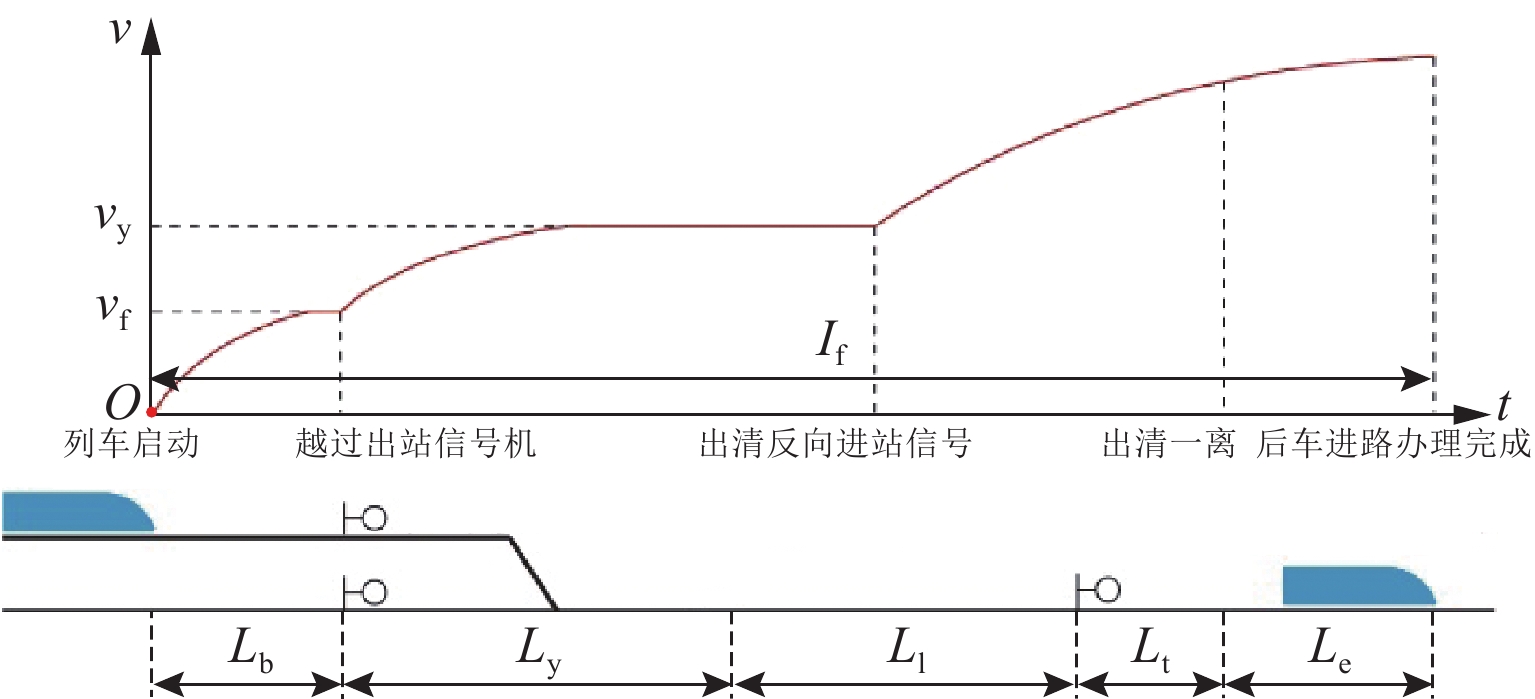
 下载:
下载:
